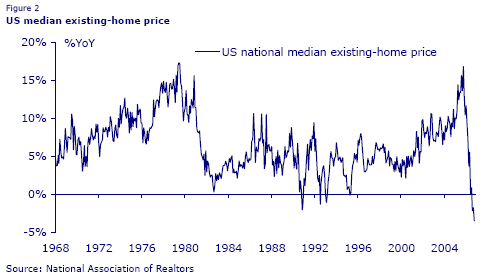Equinox Partners, L.P. - Q3 2006 Letter
Dear Partners and Friends,
The Mortgage Finance Slowdown
While Equinox is not in the economic forecasting business, we do attempt to position our portfolio on the winning side of unsustainable long-term imbalances. The heretofore unstoppable but recently stopped bull market in US residential housing is a case in point. Over the past few years as US housing prices, aided by low interest rates and innovative financial structures, have risen to nosebleed levels, we’ve been actively increasing our short exposure to the sector. Admittedly, we were a bit premature in the execution of this idea, but that said, the US housing bubble does finally appear to have been pricked.
The American housing bubble cannot be properly understood without examining the credit engine that has made this bubble possible. In the sixteen years subsequent to the last significant downturn in US real estate, a major structural change has occurred in the way America’s housing stock is financed: mortgage origination has increasingly been separated from mortgage ownership. The dramatic growth in non-bank ownership of collateralized mortgage obligations, in particular, has permitted mortgage bankers to shift their business models away from ‘interest rate spreads’ to ‘gain on sales.’ Were it not for the growing separation of mortgage origination and ownership, the current housing bubble would almost certainly never have grown so large.
Instead of slowing down with the housing market, some mortgage originators are accelerating into this downturn, a decision which should prove particularly troubling over time. Indymac, a hybrid thrift/mortgage bank and America’s eighth largest mortgage originator, for example, has been ramping up its mortgage production in an effort to ‘earn through’ the downturn. Over the past two years, this strategy of accelerating into the housing market slowdown has resulted in more than a doubling of Indymac’s quarterly originations to just over twenty-four billion dollars, a figure which coincidently is roughly equivalent to Indymac’s entire balance sheet.
Indymac’s brave strategy will work only so long as they are able to on sell the vast majority of what they produce at an attractive price, a supposition which is becoming increasingly dubious. During the nine month period ended September 30th, Indymac experienced a meaningful decline in the resale price of the mortgages they produce. Consequently, their margin on loans sold dropped to 1.12% in the first nine months of 2006, down from 1.51% in the first nine months of 2005. Indymac’s response to this unfavorable development in the value of the loans they produce has been to retain a larger percentage of their own product until the market is willing to pay them ‘fair value.’ As a direct result of this tactic, Indymac’s retention rate rose from 3% to 19% quarter on quarter. While retaining a larger fraction of the loans they produce may be financially viable in the short-run, given the size of their originations relative to their balance sheet it is certainly not sustainable for very long, a fact which Indymac clearly recognizes: “Our business model relies heavily upon selling the majority of our mortgage loans shortly after acquisition. The proceeds of these sales are a critical component of the liquidity necessary for our ongoing operations.” (page 56, Indymac’s 2006 third quarter 10-Q)
Despite posting a series of eyebrow-raising figures to their third quarter balance sheet, Indymac’s management continues to act as though everything is going swimmingly. From our perspective, however, it simply defies credulity that any thrift can grow through this downturn without experiencing at least a little discomfort. Our disbelief not withstanding, so apparently far from experiencing any discomfort is Indymac that during a recent analyst presentation Scott Keys, Indymac’s CFO, referred to their loan production division’s 53% ROE as merely “pretty solid.” Well maybe Indymac and others of their ilk can limp through this downturn while compounding equity in their mortgage production divisions at 50%+ a year, but we seriously doubt it. In Indymac’s case, this surreal ROE is belied by the unsustainable dynamics apparent on the company’s consolidated balance sheet, an observation which makes Indymac an interesting candidate for a short sale. Furthermore, if the set of problems that Indymac’s financials are exhibiting is representative of a larger trend in the mortgage industry, then the end of the mortgage finance boom may be very near indeed. Should the ultimate owners of mortgages stop paying prices that incentivize the massive origination of mortgages, the mortgage finance industry will likely return to a healthier structure in which origination and ownership is more firmly connected. Originators that own what they create will be more mindful not to create problems, and the resulting stringency in origination standards will restrict housing demand which in turn should bring the real estate boom to a clear close.
Sincerely,
Sean Fieler
William W. Strong










